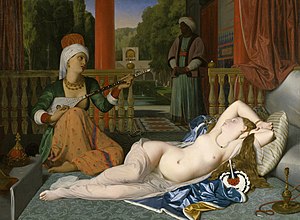Odalisque with Slave
| Odalisque with Slave | |
|---|---|
| French: L'Odalisque à l'esclave | |
 | |
| Artist | Jean-Auguste-Dominique Ingres |
| Year | 1839 |
| Medium | Oil on canvas |
| Dimensions | 72.1 cm × 100.3 cm (28.4 in × 39.5 in) |
| Location | Harvard Art Museums/Fogg Museum, Cambridge, Massachusetts |
Odalisque with Slave (French: L'Odalisque à l'esclave) is an 1839 painting by Jean-Auguste-Dominique Ingres commissioned by Charles Marcotte. Executed in oil on canvas, it depicts a nude odalisque, a musician, and a eunuch in a harem interior. The painting is in the
History
Ingres painted a number of harem scenes during his long career, starting with the
Ingres labored over the execution with his usual great care, and enlisted some of his students as assistants. One of them was Raymond Balze, who wrote of his experience:
Ingres began his studies from nature and prepared the rough sketch on his canvas, then had made by his students the less important parts, very finished, such as the architecture, mosaics, rugs, furniture, instruments, which he often had [them] reposition, reluctantly [as he was] satisfied with their execution ... Then everything being finished with the figures, he alone undertook to harmonize the ensemble with onion skins of color.[4]

In September 1840 the painting was delivered to Paris, where it won praise from critics who viewed it in the owner's home. When exhibited publicly in 1845, the painting was widely admired, and written about by Baudelaire and Théophile Thoré-Bürger.[4]
Ingres made a second version in 1842 with the help of two of his students,
The Louvre owns a carefully finished drawing Ingres made in 1858 that replicates the 1839 composition.[6]
See also
Notes
References
- Boime, Albert (2004). Art in an Age of Counterrevolution, 1815-1848. Chicago: University of Chicago Press. ISBN 0226063372
- Cohn, Marjorie B.; Siegfried, Susan L. (1980). Works by J.-A.-D. Ingres in the Collection of the Fogg Art Museum. Cambridge, Massachusetts: Fogg Art Museum, Harvard Univ. OCLC 6762670
- Grimme, Karin H. (2006). Jean-Auguste-Dominique Ingres, 1780-1867. Hong Kong: ISBN 3-8228-5314-3
- Prat, Louis-Antoine (2004). Ingres. Milan: 5 Continents. ISBN 88-7439-099-8

